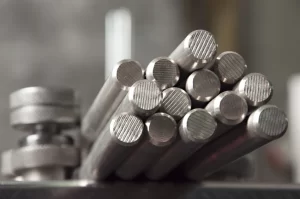Introduction
Corrosion resistance stands as a paramount property in the realm of stainless steel, a material revered for its durability and versatility. Among the plethora of stainless steel grades, 410 stainless steel emerges as a distinctive player, celebrated for its mechanical strength and wear resistance. This article delves deep into the nuances of 410 stainless steel’s corrosion resistance, unveiling the intricacies that determine its behavior in the face of corrosive environments.
Understanding Corrosion in Stainless Steel
Corrosion is a natural process that affects metals when they come into contact with corrosive agents, leading to their deterioration and potential structural compromise. Stainless steel’s allure lies in its intrinsic corrosion resistance, underpinned by the presence of chromium and other alloying elements.
The Composition of 410 Stainless Steel
 410 stainless steel is a member of the martensitic family, characterized by its relatively high carbon content and moderate chromium levels. This composition contributes to its mechanical strength and wear resistance, forming the foundation upon which its corrosion resistance is built.
410 stainless steel is a member of the martensitic family, characterized by its relatively high carbon content and moderate chromium levels. This composition contributes to its mechanical strength and wear resistance, forming the foundation upon which its corrosion resistance is built.
Chromium’s Role in Corrosion Resistance
Chromium, a vital constituent of stainless steel, plays a pivotal role in enhancing corrosion resistance. It forms a thin layer of chromium oxide on the steel’s surface, shielding it from corrosive agents. In the case of 410 stainless steel, the chromium content contributes to its moderate corrosion resistance.
Passivation: The Formation of a Protective Layer
When exposed to oxygen, chromium in 410 stainless steel forms a passive oxide layer that acts as a barrier against corrosive elements. This layer, often referred to as passive film or passive layer, prevents the underlying steel from direct contact with aggressive substances.
Localized Corrosion and Pitting Resistance
While the passive film guards against general corrosion, certain conditions can lead to localized corrosion, such as pitting and crevice corrosion. 410 stainless steel exhibits commendable resistance to pitting due to its chromium content, but the susceptibility to localized corrosion can still vary based on the specific environment.
Stress Corrosion Cracking
Stress corrosion cracking (SCC) is a complex form of corrosion that occurs when a material is subjected to both tensile stress and a corrosive environment. While 410 stainless steel is not as resistant to SCC as some other stainless steel grades, proper material selection, stress management, and environmental control can mitigate this risk.
Factors Influencing 410 Stainless Steel‘s Corrosion Resistance
Several factors influence the corrosion resistance of 410 stainless steel:
- Temperature: Elevated temperatures can affect the stability of passive films and alter the steel’s corrosion behavior.
- Exposure Time: Prolonged exposure to corrosive environments can gradually compromise the passive layer.
- Corrosive Agents: The type and concentration of corrosive agents play a crucial role in the degradation of the passive film.
- Surface Finish: A smoother surface finish can promote the formation and retention of the passive layer.
Comparative Corrosion Resistance Among Stainless Steel Grades
When compared to austenitic stainless steel grades like 304 and 316, 410 stainless steel exhibits lower corrosion resistance. While it may not excel in highly aggressive environments, its mechanical properties and corrosion resistance make it a valuable choice for specific applications.
Applications Benefiting from 410 Stainless Steel’s Corrosion Resistance
 410 stainless steel’s corrosion resistance finds its place in various applications:
410 stainless steel’s corrosion resistance finds its place in various applications:
- Cutlery and Kitchenware: Utensils benefit from 410 stainless steel’s resistance to food acids and moisture.
- Valves and Fittings: Components in chemical and petrochemical industries rely on its resistance to certain corrosive fluids.
- Medical Instruments: The alloy’s corrosion resistance is crucial for surgical instruments and dental tools.
- Automotive Parts: 410 stainless steel’s balance of strength and corrosion resistance suits applications like exhaust systems.
Addressing Common Misconceptions: FAQs About 410 Stainless Steel’s Corrosion Resistance
Q1: Is 410 stainless steel immune to corrosion?
No, while it offers corrosion resistance, 410 stainless steel is not immune to corrosion. Proper care and environment selection are essential to maintain its performance.
Q2: Can 410 stainless steel be used in marine environments?
410 stainless steel may not be the best choice for prolonged exposure to marine environments due to its moderate corrosion resistance in such conditions.
Q3: Will passivation make 410 stainless steel corrosion-proof?
Passivation enhances corrosion resistance but doesn’t make it immune. The choice of alloy, design, and maintenance are equally important.
Conclusion
410 stainless steel’s corrosion resistance unfolds as a multifaceted attribute, deeply intertwined with its composition, microstructure, and environmental context. While it may not exhibit the same level of resistance as some other stainless steel grades, it is far from inadequate. Understanding its behavior in specific conditions empowers engineers and designers to harness its corrosion-resistant properties effectively, making informed decisions that ensure the longevity and performance of structures and components in the face of corrosive challenges.
